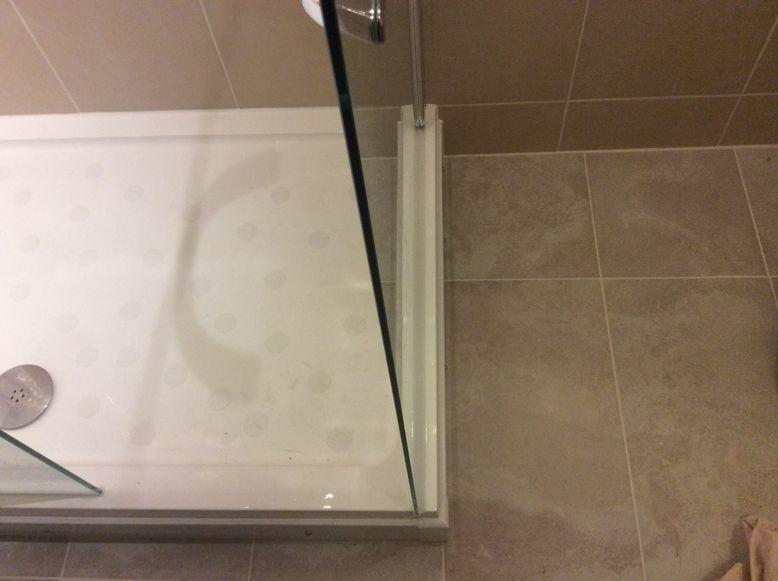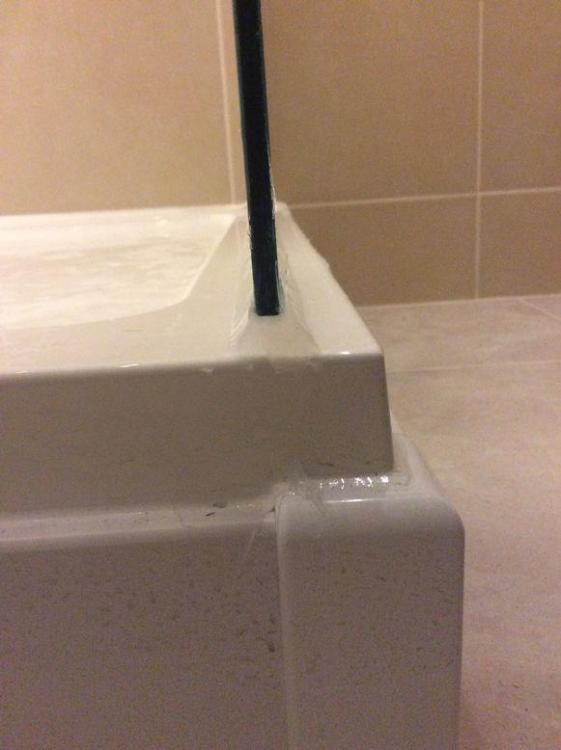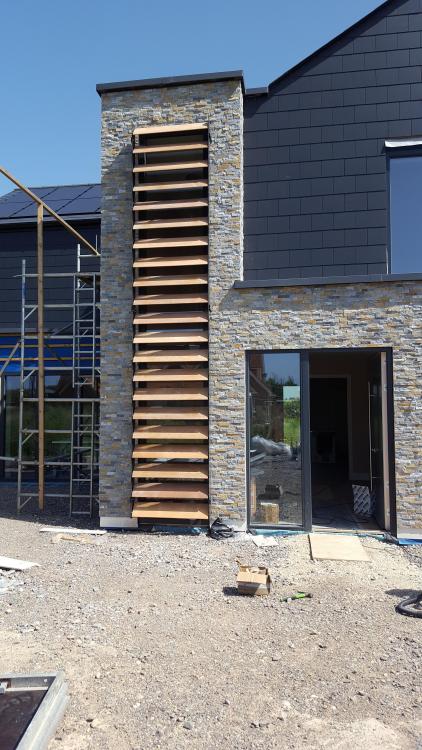Leaderboard
Popular Content
Showing content with the highest reputation on 06/28/19 in all areas
-
Here are a few photos of the refurbished bathroom when done, including the 'ease of use' items such a shower seat, except for a few finishing touches. (There are a couple of 'before aids added' photos which I have left in.) There is one more post to follow in this series, which will talk about a couple of final touches, and detail the costs of the project. [Edit: Added bonus video from the "Recommendations for Bathrooms for Elderly / Disabled" forum thread created for this project]3 points
-
So, I know I promised tales of cladding and roofing in the last instalment, but I have reviewed my photo stream and in fact realised that the window install was the next thing. At the end of November (as we all know, winter is prime building time), we finally retrieved our bargain basement windows from storage and brought them to site. Ah, the bargain basement windows, a tale of joy, horror, stress, fury, confusion and eventual revenge all in one. I should explain. When we had secured the plot and had initial drawings from the architect and were waiting for engineering/calcs/building control drawings/services/everything else, we passed the time by getting hilariously large quotes for every aspect of the design. It kept us amused. So, after reading a lot on fabric first design and passive homes, off we trotted to our local Internorm dealer. Lovely showroom, excellent coffee, charming, if slightly oily salesperson. There was much discussion about our options - I asked about passive standard 3G timber aluclad. After a while, a large figure was mentioned. A very large figure. So large, in fact, that I actually was convinced that the salesperson was having a little joke with me. He wasn't. No further coffee was offered. We gathered our coats, emptied the complimentary biscuits into my handbag and prepared to leave shamefacedly, and preferably without admitting that we were FAR TOO POOR to afford these lovely windows. On the way out, the salesman commented off handedly and rather insincerely "Sorry we couldn't help you today. Unless you want to buy the ones in the basement, ha ha ha." Reader, I have little-to-no shame when it comes to sniffing out a bargain. I cannot be humiliated. So, I was accompanied to the basement of the showroom, whereupon I was greeted with a £100,000 wonderland of window-related (expletive deleted)-ups. Results of inaccurate measuring, bankruptcy of developers, incorrect specifying, just general inefficiency. Of absolutely (expletive deleted)-all use to anyone, of course. Apart from someone who had not fully finalised their house plans. And a salesperson who is uncommonly keen on crystallising some value from said (expletive deleted)-ups. It was a partnership written in the stars. Details of hard-nosed negotiating aside (and there was someone in the room close to tears, and it wasn't me), we came away with 15 brand new windows (including 3 large sliders), a fully biometric ex display front door with side lights, a utility door, and a large panel of glass. All pretty much passive standard, some with built in blinds, some alu-clad timber, some Alu clad UPVC. For not much money. At all. A very satisfyingly small amount of money. The architect was somewhat perturbed by this moderately unconventional approach of designing the house around already purchased windows, to say the least. For a while, I had a Quooker tap and approx £80,000 of windows as my only purchases for the house. However, he came up trumps and designed the house in such a way as you would never know that he had any design restrictions at all. The man is a quiet genius. We had cherry picked the best stuff - so all our sliders for the bedrooms are approximately (but not quite) the same size, they vary by about 30mm here and there, but they are all on different elevations of the house so you never see them right next to each other. We wanted to use one particular window in the bathroom as it had built in blinds, but it was a little too big, so we sank the bath into the floor to allow the window to have opening clearance. It looks amazing and like an intended "design feature". So, we purchased the bargain basement windows, and following our cynical, but realistic architects advice - we got a trailer and got them the hell out of that warehouse. They stayed wrapped up and palletised for approx 2 years until that fateful day in November. Now, what we should have done was quit while we were ahead, taken note of the surpassingly large number of (expletive deleted)-ups and run like the wind away from that warehouse. You will not be surprised to learn that this did not happen. We still needed our large feature window - a 5m wide, 2.7m high alu clad timber lift and slide window and matching fixed panels above. This was not cheap. Very very not cheap. But it was lovely. We decided that as we'd saved so much money with the rest of the windows, we could justify this lovely thing. We got a good, although still bloody expensive price on it, paid a 50% deposit, and were instructed to let them know when we were ready to have the window produced - as we hadn't been through building control fully yet, so didn't want to press "Go" just then. So, all well. We got on with what we needed to do, engineering, building control, life etc and gave no more thought to it. We get our building warrant. We phone up the showroom to say "yay! please make our very highly priced window!". Only, there's a disconnected tone. Odd, we think - must have misdialled. We try again, same thing. We google. Website down, emails bounce. A light sweat breaks out. The insufferable shits went bust. No one told us. It may or may not be directly related to the basement of (expletive deleted)-ups. Internorm had never heard of our order and had not received our deposit, so couldn't help. Now, thank christ that I am naturally untrusting of salespeople and INSISTED on paying £101 of the VERY LARGE deposit on a credit card. Section 75, how I love thee. We got the whole lot back. Eventually. After a lot of paperwork and phonecalls. But now we have a load of second hand windows, some with bits missing and no-one to fit them. And no-one to order our lovely slider from Help was on the way from an unexpected quarter though. Our house build is being filmed for TV, and we happened to have a filming day a couple of weeks later. Someone on the crew gave us the details of a helpful person within Internorm, who passed us on to another dealer who honoured the original price for the sliders, came up from England to fit the windows, supplied all our missing bits and were generally wonderful. So, we come to November. There are two access points to our site - one at the rear, which we can just about fit an articulated lorry up, and one at the front, on the extremely busy main street, that is cobbled and 2cm narrower than a transit with the wing mirrors folded, and only just as tall. The Internorm dealer had already made a site visit to review the access and made many sucky-teeth noises, but said "it's ok, we'll get a robot handler up from Leeds that can hold the window at 45 degrees while we drive it up." "Ooooh", we think, "A robot! Technology will save this whole scenario". The day started relatively badly when it transpired that the artic driver, instead of turning right when he should have, so he could drive straight down the street and have the windows on the correct side for unloading, had in fact, turned left and was now in the middle of fully reversing down a medieval street so long that it takes approx 8 minutes to walk from one end to the other. At 9am. Also, he was (I think) Romanian, with no English, and there were no Romanian speakers amongst the installation crew. So, when he finally arrived, after monumentally pissing off approximately 14 million local residents, the windows were on the wrong side and no room to turn. So we had to unload the rest of his lorry, stack it up on the street, taking up virtually every parking space in the place and drive the telehandler across the street, blocking all the traffic to get the window off. It is massive. Securing it on the tele handler is not a quick process. There was a lot of shouting. Also, did I mention I'm 6 months pregnant at this point? So, once unloaded, we look around eagerly for the promised technology laden robot. Looking a bit sheepish, the install crew confessed that it hadn't been available, but "don't worry, we brought something else". Great, I think! No problemo. The "something else" appeared, to my untrained eye, to be a couple of skateboards. So, we ended up with our massive window being rolled up the close on a couple of skateboards, being held at 45 degrees by a telehandler and 10 or so guys not all of whom shared a common language. To be honest, it went better than it should have done. The only hairy moment was when the tyre of the telehandler hit a drainpipe and it cracked with a noise EXACTLY like breaking glass. I was at the street end and couldn't see the window, just heard the cracking noise and a lot of a shouting. I was pretty convinced I was about to HAVE the baby. Terrifying. But, all in all ... TADAHHH! Over the next couple of days, all the windows were fitted and we were (nearly) watertight. Exciting progress.1 point
-
Having done a large renovation project and turned an old 1770s vintage wreek into a fantastic Home we decided that living in Cheshire was no longer for us, so we sold up and moved, to be closer to family in the Southern Lake District. However the journey was far far from straightforward, we really had no idea what we were looking for, was it to be another renovation project or a self Build? Having viewed around fifty ‘oportunities’ ranging from dilapidated houses, to an old pub, to a closed garden centre, we gave up!! Then about six weeks after ‘giving up’ Debbie had to come clean, she’d not actually given up, but had been searching online and she thought she’d found what we were looking for. So we arranged to view a rather sad looking dormer bungalow on a very wet, cold and overcast March day. Once into the property we both realised this was the one! So we bought it and moved in. Having lived in the property for a year it was clear that this wasn’t a renovation job, so the bungalow had to go. The next step was to decide what to replace it with. Although we had it in mind to downsize we missed the larger rooms of our previous home and. According to my interior designer (Debbie) we needed larger rooms so our furniture would fit.... Living in the old bungalow made it obvious it was the wrong way round, the two bathrooms and the bedrooms had the best views. Also because of the shape of the plot, an L shaped house would make the best of the space and the views. Once we had our requirements clear, a design brief was produced and a local Architect appointed. A series of design options were produced and after some tweaking, final plans drawn and planning permission sought. Prior to the submission of the planning application we walked round our neighbours with the plans, this gave us an opportunity to gauge their response, in most cases it was ‘interest’ and nothing more. Thankfully the planning application went through without any opposition. So here is the design.1 point
-
i have worked on a few houses where we didnt build the upstairs, we did however put all the materials for finishing it off upstairs, this was so that the client could get the vat claim on the materials1 point
-
The RH inside my house would often drop into the mid twenties, it caused cracked lips and nosebleeds amongst other things. It made very uncomfortable living at that level of dryness. My optimum RH for my health is a few percent either side of 50. We rarely got above mid 40’s even in wet weather and mid 30’s was the norm. We are a 200sqm single storey with just two occupants (one of whom out all day) plus woofer. One bath, one shower, not a lot lot of ‘wet’ cooking (although at one stage I was boiling pans of water to try and get humidity up and I bought a humidifier too which was a chinese rubbish job). The level of activity in the house did not create much moisture and that may have contributed to our very dry atmosphere plus our exposed windy location. Retrofitting the enthalpy unit - even though expensive- has changed the house totally. We now sit at about 50% RH on average and the house is much more comfortable. Best retro money I have spent only wish I had specced it at the start but I was told I wouldn't need it when I asked.1 point
-
When cold outside, the relative humidity (UK) is quite high, but when heated in the heat exchanger it drops. In the meantime the stale, warm and wet air on the house is cooled and so gets to saturation, hence condensation and water drains out. The enthalpy part will remove the moisture from extract and add to supply. Is it really needed? We don't have this, the relative humidity inside is between 40 to 50% and quite comfortable. Perhaps people with some skin conditions might benefit from higher humidity? Not sure.1 point
-
Because they are difficult to explain and expensive to produce ..! They are also a little more fragile than standard heat exchangers.1 point
-
My arm was nearly back to normal following the Monday afternoon steroid injection which meant a full 3-man crew. The wagon reversed right up to the garage foundations and delivered the concrete mid way into the garage slab position and we managed to spread out the 5 m3 of concrete inside the allotted 20 minutes. There was a worrying point half way through the pour when the driver said he doubted the load was large enough to get to the prescribed floor tamping level. I said I had rounded up the order from my calculated 5.1 m3 to 5.5 m3 to be on the safe side. He looked concerned, went off to the cab and returned with a bit of paper saying the load was 5.0 m3, so we shuttered off the 2.5m x 1.8m store floor extension to the main garage to avert a complete disaster and then bought the concrete level up to FFL in the main section. In the end 5.0 was enough for the whole floor including the store floor with two shovels of excess. One hour after the pour started I carved a 1 in 10 gradient ramp at the door threshold. This initially looked terrible until I cut the tamping 4x2 batten down the width of the door (2.7m) and then tamped down the ramp surface in the semi set slab. Looking good today.1 point
-
Finishing grade: well not quite but good enough. Where from? My girlfriend Jackie at Haldane Fisher ?1 point
-
I think you buy them direct from the manufacturer i think mine where BLAKES. If they come bent send them back, no different than buying anything really. They really are hard to damage, imagine some of the Neanderthal blokes that use them.1 point
-
My extract motor is set at 25% for 1, 45% for 2, 75% for 3 and 100% for 4. The system runs at number 2 all the time. I have never had to increase the speed and in the bathrooms there is no condensation. IIRC @JSHarris said he had fitted a humidity sensor but that it wasn't needed.1 point
-
Q: Why do you think you that conduit? Is space tight? You think it will look neater? My experience is that the actual UFH pipe is reasonably flexible and if where it comes out of the floor and is connected to the manifold (direct connections are highly recommended) it is hidden away or boxed in then the "look" is not so important. Q: To protect the UFH pipe? I would recommend having different loops of UFH in different section of solid floor I strongly recommend pressure testing the pipes before you pour. If there is a problem once the concrete is set off, then you are in a whole load of misery to find and fix the leak. Connect the loops to the manifold, open all the valves, fill with water and leave for an hour or two. Fix any leaks, try again. Rinse and repeat (pun intended) Yes. Just be careful See answer regarding expansion joints.1 point
-
I have found that no boost is needed in shower/bath rooms. I just leave the flow rate at the same low rate and there are no condensation problems.1 point
-
Yep... the reason is because humidity varies and you can’t have a “standard” humidity at which to boost. Most people have used motion systems or just a link to a light switch is enough to make it boost when it is needed. Its about simplicity ....!1 point
-
I wish I had specced humidity sensors and enthalpy unit. As it is I have had to pay vat on enthalpy as bought afterwards and at nearly £1000 not cheap. I dont have the sensors as we didnt wire for them and its a pain as I have to be aware of when someone has shower and zap it up manually. It worries me that when I go away my housesitter will not get to grips with the ipad controls (or forget) to put it up manually and I will come back to a nasty damp wetroom. I have 4 settings. One is a humidity suppressant so if 'off' it will still draw out a bit of moisture. 2. is 30% below building regs, 3. is building regs and 4 is blow your socks off boost.1 point
-
Only for a new build, not for an extension. All work after completion and a single VAT claim is VAT rateable at the correct rate.1 point
-
So - this is the white ABS version in situ, and the prototypes have been hoicked. It is slightly out from end to end, but the glue - in addition to being industrial strength and then some - has enough body to pad it out. The edge needs slight tidying with a smear of silicone. I may not even put the screws in. And I have put a bead of silicone along the bottom. That wall mount is a hinge as it is the bath screen reused, but it should stay firm now. Alighnment seems OK. But the silicone bead - despite one of those gummi-bear profiler things and looking OK - is not quite as smooth as a Levy worthy of a visit from a Chevy. And the gap is larger than I would like so I may be tempted into adding a little extra whilst it is still mint. Plus a bit of untidiness to take off once set firmly. So, big thanks to @Temp and a donation coming for BH.1 point
-
Good lad. If it were me, and I was were I was, eg were you are....... i) accept a bit of short cycling of the boiler when running the UFH only, but do the following to reduce it; ii) take 22mm boiler flow and return to the UFH manifold ( or 15mm if that's what your plumber ( on his mother's side ) left you with ) and tee off both pipes immediately after they arrive at the UFH TMV, iii) fit a 22mm 2-port zone valve between flow and return ( 15mm reducing sets will fit into the nuts instead of olives link ) iv) set the motorised valve to open when the UFH ONLY is on to give a super-duper bypass, and for it to close when the other heating is on so as to not give problematic bypass. Winner winner, chicken dinner. Don't forget to not do that ok.1 point
-
Bit too late but Google found.. £11 a month.. https://freeola.com/line-rental/?gclid=CjwKCAjw0tHoBRBhEiwAvP1GFXs2dVIBXCkzqqI5MpfTqaEqLPQeB292OKKWkiYzeC57_OsDgz3s6hoCRZwQAvD_BwE But I've no experience of them. Don't know if they can handle an installation.1 point
-
As a tiling contractor I’ve never seen anyone use the levelling systems I suspect it would be expensive and slow on large areas I and the tilers that work for me use spacers I don’t allow growing the spacers in I was caught out on one job Take your time and keep checking1 point
-
This may be of interest to you. If your sitting within the opening of ICF, details are floating about here somewhere. I’ll link to them if I can find them.1 point
-
1 point
-
FOI the entire planning file for that address, or the earlier time period, specify that PDF by email is acceptable, and you may get the whole lot surprisingly quickly. Though they may try and charge you as it is old, or argue that since there is a scheme to access is at reasonable cost then they are entitled to divert you into that scheme. Or just make an appointment to inspect the file at the office, which is your basic right. Take an iPaD to make notes and use the opportunity to take piccies of the docs if it comes. Angled piccies followed by an image stretch program works quite well Ferdinand1 point
-
Like all Self builders we found we had a limited number of options for living accommodation during the build, given that we needed to demolish the bungalow to clear the plot for the build. The options were, rent locally or a caravan on site. Renting locally wasn’t an option due to the high rental costs, so we looked at the caravan option. The main problem was access, an 8 feet wide drive with a hairpin bend half way up, a dry stone wall, 80 feet tall trees and limestone outcrop put paid to that idea. A local crane company visited the site to look at the feasibility of craning the caravan over the trees, the narrowness of the road, a road closure and 4 mile diversionary routes for vehicles, a licence from the local authority soon put paid to that idea. Then a brief conversation with a neighbour and a lightbulb moment, we can up with the idea of a timber framed tiny house built in an orchard that formed part of the plot. The day before submission of the planning application a sketch of a small 7 x 5m cabin was added to one of the drawings. Thankfully we got planning approval. The construction of the cabin allowed us to practice our woodworking, insulation and other construction and trade skills. This is where we currently live. This what it looks like on a wet autumn day. Not the power cable over sailing the cabin. Happily the DNO installed taller poles to increase the clearance.1 point
-
So, I just remembered that I actually had this blog. I'm killing time waiting for a phonecall, so, updates! Over a year later! Stuff has happened. Lots of stuff. Lots of money. Many tears. Some moments of "FFS, what?!", many moments of "HOW MUCH?" and "how the feck does this bloody shower fit together?" and a few, rare, beautiful moments of "woah, that looks awesome". The last entry ended on a lovely "woah" moment of the successful pouring of our beautiful concrete floor throughout the ground floor plan. It pissed down the next day, obviously. Then MBC went away, laden with cakes, pies and phone numbers of eligible single ladies from the area. A week later, they came back. My new job is a long commute away, and I had to work that day. On my way to the station (hideously early), I saw a truck drive past, laden with bits of house. "That's our house", I thought to myself, I just knew it. I text my husband to share the momentous culmination of our wonderful joint enterprise and was mercilessly mocked that it probably wasn't our house, as it was far too early. Ha! How I laughed when the driver called him approximately 10 minutes later to say he was stuck in the narrow road outside our site, couldn't turn the lorry sharp enough to get into the access point and was blocking every single (extremely angry) person in our medieval town from getting to work. That was a brisk drive to site for him. There were many people in hi-viz, a lot of shouting and gesturing, a lot of sharp intakes of breath, a few calls to the police to track down owners of badly parked cars and a huge amount of car horn tooting. Oh, and a LOT of apologising. But, the truck made it into the site. Just. To the never-ending delight of my small son, there was also an absolutely ENORMOUS crane. I was later informed this in fact this is an embarrassingly tiny crane, the smallest one that you can possibly hire and really hardly worth the bother. I feel like the driver may have had some adequacy issues with his crane size. So, whilst I was in a meeting, they just wacked the house together. At lunchtime, I called for a catchup FaceTime and the ground floor was pretty much finished! I mean, WHAT? The speed was insane. By the time I got to site later that evening (about 7.30pm), all the ground floor panels and internal partitions were in. My husband and I just walked around rooms, giggling insanely to ourselves at the ridiculousness of the whole thing. The next day, second storey on. Unbelievable. By the end of the week (in fact, I don't even think it was full week) the whole frame was up. We were a little shellshocked, to be honest. There was a lot of head scratching about how to run the falls on the roof. This had been discussed and obviously designed in, but our roofer had some input whilst MBC were on site. They were very good and spent a lot of time working out the best way to make it work for what we needed (singly ply membrane roof, adequate falls, hidden box gutters) and did a lot of extra work in conjunction with the other trades. Our roofer also risked the wrath of his wife by coming to a site meeting on a saturday and was subsequently late for a family BBQ oops. Oddly, once the frame was up and see could feel the room sizes in 3D, they suddenly felt absolutely massive again. Such a convincing illusion - it's very hard to visualise 3D space from a 2D footprint. Next up? The joys of roofing and zinc cladding And winter1 point
-
Since my last blog post things have been fairly quiet. Our frame manufacturer, Lakeland Timber Frame, have confirm that our frame is in production and we have a date for erection of mid January. The crane company have visited site to check the narrow access and hairpin bent for themselves, they’ve confirmed that their smallest crane will be able to get onto site, with difficulty! Ss with a start date agree it was time to get the scaffold up. Originally I’d considered buying my own and selling it on after the build, however that option would have cost me £12,000. The alternative was to hire scaffolding and get it erected at a cost of £5,000. After a lot of careful consideration I’ve gone with a local scaffold company. Looking at the size of the scaffold and the shear amount of scaffolding required, ii think I’ve made the right choice. So far they’ve used six wagon loads of scaffolding kit and it’s taken 9 man days to errect. I recon there’s another 2 days to finish it off. The other thing I’ve had on my list of things to do, is get all the very tall Ash trees inspected. This is the sort of thing that tends to be low on my agenda as it’s not really Build related. However it’s just moved up the priority list after a loud thump at 3am yesterday morning. The tree just missed a plastic oil tank and party constructed outbuilding and the site loo, that’s it under the branches on the right. I couldn’t get far enough back to get the whole tree into shot, I recon it about 120 feet tall (long!). If it had fallen the other way it would have flatten on our residential cabin and us! I’ve got about six more of these and they are all going! The tree also took out the overhead power lines and at one stage 65 homes were without power for 6 hours whilst the cables were replaced.1 point
-
Because our site was on a slope we always envisaged having a walk-in basement, that’s a basement surrounded on three sides by the slope and open at the front to a lawned area. The architect recommended a structural engineer to design the basement walls, what I hadn’t realised until it was too late, was that the design would be way over-engineered. His design is for a 200mm thick steel reinforced poured concrete wall tied into the basement slab. The slab and retaining wall contains about 52m3 of concrete and 3.5 tonnes of steel. The only saving grace is that it sits on an insulated raft designed by Hilliard Tanner and has UFH pipes cast into the concrete. So here we are just about to start pumping the concrete into the insulated slab. Next, the ICF basement walls were put together, a bit like Lego. Here you can see the completed walls braced and ready to receive 26m3 of concrete. Finally, the lounge section of our insulated raft foundation was done to complete the three-stage foundation project. In this photo, you can see the insulated raft and its steel ring beam under construction.1 point
-
Having promised my wife Debbie that I’d get people in to do most of the Work associated with the new house, i contacted two local demolition companies and got prices to demolish the old timber bungalow. The prices were £6,000 and £12,200. Being tight I demolished it myself, it cost the price of three skips, £540, The bonus for me was over £1,000 in payment for the scrap from the house, things like a hot water copper cylinder and piping, lead off the roof, the old cast iron AGA and two baths, the oil fired boiler, taps, light and socket fittings etc. The problem in demolishing a timber frame house is the amount of timber! So I saved as much of the timber as possible and cut up the rest into firewood sized pieces, I used leftover builders bags to store it and we’re burning it very slowly in the cabin, the problem is the cabin is so well insulated we only managed to burn half a builders bags worth last year!. An even biggest problem was the cedar shingle roof, it had been re-covered during its life so the shingles were two layers thick. I ended up cutting the roof up using a reciprocating saw, a lot less dangerous than a chain saw! The roof as then burnt on site, The roof being stripped. It’s going slowly! Progress. Finally clearing up the plot. All told it took me six months to dismantle the old bungalow and clear the site. luckly my time is free and I did save £6k and taking the scrap value into account I’m £7,000 in pocket to spend elsewhere.1 point
-
Our site slopes, so we had the idea of digging into the slope and creating a walk in basement. Having done two trial pits into nice soil and clay during the initial design phase, we were confident that it was a simple soil dig out sort of thing! Once the bungalow was demolished it became clear we’d quite by chance dig into the only two areas of soil and clay and the house had been constructed on a large lump of limestone rock called Cumbria. After a hit of head scratching and a coffee with my neighbour Brian, he’s the ‘go to guy’ if you have a problem, as he’s usually got a solution and the solution was a local guy called Chris, a man with a machine and a pecker. Chris arrived on 1st November and twelve weeks and an estimated 1,200 tonnes of rock later we had a basement. Here he is starting clearing the site. The basement hole starts to take shape. This is about half of the stone removed from the basement hole.1 point
-
We have our building warrant, FINALLY. I have a new job. The small one has started school. MBC are here. The glorious day of the 29th August arrived, and so did the vans, carrying Brendan's crew. The sun was shining, tonnes of sand were delivered and painstakingly spread out. It's amazing how much time the MBC boys took to make sure everything was exactly level before carrying on, I found the level of care that was taken very reassuring, and of course Sean was on hand with a terrible joke whenever required. Sometimes, also when not required. Our months of waiting for the building warrant were not completely unproductive as we now have a pimped out site office, including a cast-off white leather sofa (practical colour choice for a building site), high speed wifi, a gopro to capture the build, a desk (with executive chair), first aid point, filing cabinet, H&S kit storage, many many many copies of all the plans, and most importantly of all, a tea/coffee point with fully stocked biscuit drawer. "Luxury!", as the MBC boys proclaimed. Drainage channels were hand dug the next day - a nervewracking time with measuring and re-measuring. The brand-new-just-out-of-the-box Bosch laser measurer was ceremonially launched from the top of the rubble pile by the small one, landing with an ominous crunching noise. "That will hardly have affected the accuracy at all", we thought. Still, at least we know who to blame if all the drains are in the wrong place. Over the months/years we have had various thoughts about where the kitchen island should go, but now we come to decision time. The drains and conduit must go in, today, and they are non-changeable. The island will be all our workspace (the rest is floor to ceiling units) so needs an electrical feed and hot/cold water as well as a drain for the sink, waste disposal and dishwasher. So, instead of making a decision that will inevitably be wrong, we decide to put in the two final options. 1: The architect's recommended positioning that we think is too far away from the sunny spot 2: Our preferred option, closer to the large sliding doors We try and position the pop ups in such a way that the unused one will be under a sofa or table and hopefully not too noticeable. It is almost guaranteed that the architect will be right in the end, as he always is, but it's a struggle to commit at such an early stage. The unused one will be cut off, and topped with an official plaque set into the floor, engraved with "always listen to the architect". We're justifying it as a feature. The next day was the delivery of the EPS on a very large lorry. Our site is right in the middle of town and the access is surrounded by garages and illicit parking. This time of year, there are no students around, so although the lorry is a tight fit, there are no hastily abandoned cars in the way. Next month though.... The EPS ring beam is fitted and the footprint of the house becomes rapidly visible. Although pre-warned by our architect that the space would look small with no walls up, we are both thoroughly freaked out and convinced that the rooms are all too small. There is measuring, re-measuring. comparing against plans... but nothing we can do. Thankfully, on our way back to the rented place, we drive past a new build estate that is also just at foundation level. We slowly realise that the footprint for those homes contains a 3-bedroom house AND garage. Ours is generously sized in comparison, to say the least. The next few days are taken up with making steel reinforcing cages, laying UFH pipe and checking the drainage (again). My time is spent at work, obsessively checking the weather forecast. We have, against all sensible and knowledgeable advice, decided to attempt a smooth concrete finished slab. No tiles, carpet, wood, screed, diamond polish … nothing. Trying to explain this concept to the many people involved has not been easy. Reactions have varied between trying to convince us that diamond polishing to a mirror finish is hideously expensive (we don’t want a mirror finish – there are deliberately no shiny surfaces in the whole house, as I am obsessed with matt finish and hate polishing) to “but it’ll look like a B&Q warehouse!” (my dad). MBC are also not keen AT ALL, due to a problem they had with a previous job where the finish didn’t work and all the window/door thresholds had to be redone to allow to an additional screed to go on top. Showing people a photo of a farm shed floor that had been done by a friend by just powerfloating the surface for longer than normal did not help. The conversation went along the lines of the following: “This is the finish we’d ideally like, it’s a farm shed.” “…..? A farm shed? For cows?” “Yes” “But, polished to expose the aggregate? What kind of aggregate do you want?”. “No, no aggregate. Not polished. Just powerfloated.” “But it won’t be shiny, and that needs specialist tools.” “We don’t want it to be shiny. Just smooth. Like the IKEA warehouse. Or B&Q”. “………….really?” “Yes” “hmmmm.” (sucky teeth noises follow..) The process was somewhat wearing, but we rode confidently over everyone’s objections and doubts anyway and carried on. One thing we did know (from our farm shed creating friend) was that rain during or shortly after the pour would be bad. Very bad. It’s September, in Scotland. Could have been worse. Two week ahead forecasts are notoriously inaccurate. Right? Right? I had seven different weather apps on my phone at one point, all saying the same. Thunderstorms. A 14 day forecast went to a 10 day one, then a 7 day one .. rain all week, particularly heavy on the day of the pour. Just to put the cherry on top. The day before we poured the floor, it tipped down all day. Not 5 minutes passed without freezing rain. The next day, I left for work, having deleted all the weather apps and given up all hope of a polished floor. At the site – not a cloud in the sky. Brilliant blue skies, sunshine, tonnes too much concrete. The MBC crew powerfloated the slab for much longer than they normally would, and by the time I saw it at 8pm that night, it was as smooth as we could have wished for, and a beautiful mottled grey. If I wasn’t a rabid atheist, I would have sworn I heard a troop of celestial trumpets playing. So, a perfect end to a brilliant first stage of the build.1 point
-
So, after the last entry - we had a clear site, filled with many, many tonnes of compacted hardcore. All was well. No more digging, the wobbly wall hadn't fallen down, angry neighbours had been pacified with cake. Onwards and upwards! Well, not quite. We still didn't have our building warrant. We had applied for a staged warrant for foundations and frame, naively thinking that this would be quicker that going for the full thing. We had submitted the MBC plans, MBC engineer drawings/calcs, SAP calc, double checked Scottish engineer drawings and the engineer certificate that is required in Scotland. We were ready! Our local council gives the building control department 20 days to respond to applications. 20 working days. We had worked with a chap in that department before on a previous house who is very nice, helpful and reasonable. He had been giving us informal advice and help throughout our nightmare planning process. Surprisingly, our application didn't get assigned to him. Nevertheless, we were optimistic - it was early February, and we had a provisional date with MBC of the 18th of April for starting the foundations. Everyone thought that was a reasonable lead time; helpful BC chap, the architect, the planner, the engineer, MBC..... After all, we had the SER certificate, everything had been checked and triple checked, and we were only asking for the Stage 1 warrant. I could say a lot more about this process, but I will restrain myself. Let's put it this way - towards the end, my husband and I gave up using words in text messages and communicated about the build solely in memes. We got a list back of queries (after the first 20 days). Fine, we were expecting that. This consisted of points such as why some documentation was printed in A4 when it should have been in A3, a page numbering error, the mention of a standard detail in the MBC drawings that is not standard in Scotland.....the list was 3 pages long. And not in an unreasonably large font. So, we responded to the points. All of them. Another 20 working days pass - we get a response to the first point, and another question. We send the answer back. Another 20 days - a question about the second point arrives. You can see how this went. Frustrating is not the word. There aren't really words to express the level of rage that existed within our house during this time. Hence the memes. We got our warrant on the 6th September. We eventually worked out that there had been a mix-up somewhere and our application was being assessed as if it were non-staged, hence all the seemingly irrelevant questions about electrics and MVHR points. So, the staged warrant was reissued as a full warrant on the same day as I got confirmation that I'd got a new job after redundancy. That was a good day, and the hashtag #ginforbreakfast was born.1 point
-
So, after the last entry, we were back to scratch again, having managed to secure an additional piece of land and an alternative access to our plot. Lots of measuring and pacing out later, we were able to basically take what would have been the 2nd floor of the planned house, and put it on the ground floor. The ground floor footprint was made considerably bigger by this, and the overall shape was much less "passive-friendly", but for our tight site, it really was the only option. After a lot of refinements with the architect, he came up with a design that we absolutely loved, gave us privacy from the surrounding buildings, parking AND a little garden. So, some pics at last! Before we got the additional land, we had bought two of the pre-fab 50's garages that back right up to our site and intended to demolish them to gain access. This photos shows a peek of the site through the first panel we removed. There was a massive step up from the ground slab of the garage to the soil level of the site. Looking back, this should have been our first warning of problems to come... The site was a former garden centre, so there was a large timber building (previously a showroom), a play house, a load of slabs, display boxes, plant racks, millions and millions of plastic plant pots everywhere, and 5 world-weary apple trees to get rid of. And a lot of topsoil. Did I mention the topsoil? It was a LOT of work and expense to get rid of all this stuff, as it all counted as "mixed waste" so the disposal fees were enormous. This is when we realised the importance of being on site to supervise. We'd had a holiday booked for months and months before we knew we'd be doing this work, so we briefed the guys doing the clearance (who we trust) who estimated the remaining skip loads. We get back a few days later to discover it had been over double that number and our digger driver had got into a dispute with the skip collection driver over what counted as "waste". So instead of the expected bill from the skip guys of about £2-3000 at the absolute WORST, we came back to a bill of over £10k. This necessitated a somewhat hasty trip to the skip yard and a "full and frank exchange of views" with the owner. After showing us a random picture of some rubbish on his phone and insisting it was from our site, our bill was halved. Left a nasty taste in the mouth though, that's for sure. So, we eventually have a clear site, and now another problem. If you're a gardener, you'll appreciate how lovely this topsoil looks. And it is great quality - this plot has been used for nothing but gardens and grazing since medieval times. Unfortunately, that leaves a rather extensive period of time during which the topsoil has nothing to do, but get deeper, and deeper and deeper. By the time we came to own the plot, the topsoil and subsoil layer was over 2m deep in places. Obviously, (after it was explained to us), you can't build a house on top of topsoil. Things grow in it. Things you don't want under your house. So, it had to go. BUT, we couldn't drop the level of the house by 2m, as the plot is surrounded by other buildings and dropping it down that far would cut out essentially all the sunlight coming into the house. If anything, we wanted it higher than the current level to maximise the light. Two options - piling with a suspended floor or simply replacing all the soil with compacted hardcore. We also (briefly, until we got the quotes in) considered adding a basement. That idea didn't last long. After speaking to Hilliard about piling, he mentioned that each pile would potentially be a partial cold bridge, so that was a little off-putting. But we got quotes anyway - they weren't horrendous, but a lot of piling companies weren't massively keen on the site, surrounded as it is by 3 storey blocks of flats, a listed street frontage, crumbling stone walls and potentially a LOT of angry neighbours. Despite this, it was an option we were considering, until every warranty company we spoke to said that they wouldn't issue a warranty for mortgage purposes if there was any black earth under the footprint of the house. So, many many many many tractors and trailers (and pots of money) later, 1000 tonnes of soil was dug out, and replaced with 1000 tonnes of hardcore. And not any hardcore. Due to our engineer (about which a LOT more could be said), it's all Type 1 MOT. All 1000 tonnes of it. Compacted to within an inch of it's life.1 point
-
At the end of the last episode, we were the proud owners of a landlocked, overlooked, overgrown plot in the centre of a medieval conservation area. Easy to develop, right? The plot was accessed through a narrow close, about 2cm too narrow for a transit (even with the mirrors folded and a brave/careless driver in charge), so completely impractical for the creation of a new house. On either side, the plot is overlooked by 3 storey blocks of flats, tight up against the boundary, and at the rear, by a selection of very attractive 50's, harled, concrete panel lock up garages. There are 8 of these that back onto the plot. So, to cut a long story short, we ended up having to buy 2 of these garages, pay extensive lawyers fees, carefully take them apart and store the bits to allow us proper access to the site. They were not cheap. They were so not cheap that we couldn't afford to knock them down - we're going to put them carefully back together when we're finished and sell them to recoup some cash. The plot, as it stands, consists of two traditional Scottish rigs, covered in a LOT of topsoil, ivy, an old timber shed and a million old paving slabs. Hopefully no Viking longships or bodies. The space itself is very tight, limited in the height we can build to and with lots of overlooking/privacy issues. Our architect came up with an initial plan of an L shaped building, overlooking our own courtyard garden with no windows on either side gable to avoid privacy issues. We liked the design - the planners liked it, our neighbours and various local groups very much didn't. We had numerous objections including "inappropriate use of modern materials" (newfangled wood/glass), "destruction of the rig structure" (it was abandoned waste ground and had been garden or pasture since pretty much the founding of the town) and so many others that I can't even remember them all. We had to go to planning committee, where we were advised that it simply wouldn't be approved with a flat roof design, so back to the drawing board we go. We end up with a quite compromised design, three stories and with all the complexities that brings. No-one was very happy. We passed committee and got our planning. So, to building warrant stage we go - back and forth between various build methods, SIP being the front runner for a long time. Numerous engineers, foundation meetings, quotes and drama, we end up with a building warrant package ready to go. The DAY before submitting the package to building control, we heard the news that we could potentially obtain some land next to our plot boundary, and improve the vehicle access. After tears of frustration and chucking away all the work the architect had done, we realised that actually it was a stroke of luck and we could radically improve the design, the floorplan, the access AND the garden area. Never mind all the work already done and the time spent .... BACK to the drawing board, AND planning, all over again.1 point
-
Six years ago, we had a casual conversation with an architect friend about the fact that we'd like to build our own home. Taking the resulting vague, non-committal "hmmmmm" as rampant, unbridled enthusiasm, we started looking for plots. First thought - our very own back garden. It was massive, a pain in the arse to garden, and it would be free! Back garden plot Pros: - Free -Less gardening Back Garden Plot Cons: - On a notorious flood plain - Not actually where we wanted to live On balance, we binned that idea. But not before paying the first of many fees to the local council to be denied planning permission. It was at this point that my out-of-control addiction to giving money away to the local council (or anyone, actually) began. Second up was a plot in an outlying village, about 2 miles from the place we actually wanted to live (but couldn't afford). Lovely plot. (someone else's front garden, giving them the classic double whammy of less gardening AND extra money to spend during the leisure time they'd have gained by not gardening) Local village plot Pros: - Nice road in semi-posh village - Little school - Pub - Services on site - South facing Local village plot Cons: - A LOT of trees - some with TPO's - Not free - Still not where we REALLY wanted to live - Quite small This was a tough one. We knew that we'd never get a plot in the dream location, but was it a compromise too far? Whilst we were swithering about plot 2, an unbelievable opportunity came up, right in the centre of our dream location. Dream plot Pros: - Where we REALLY wanted to live Dream plot Cons: - Lots - Who cares? - No money for the rest of time Needless to say, we went for it. So, that's how we ended up with an inaccessible plot, complete with a ransom strip owned by someone else, surrounded by a million overlooking flats in the centre of the medieval town. Next up - how we got access to the plot (hint: expensively) and fulfilled my need to give away some more money to the council.1 point














